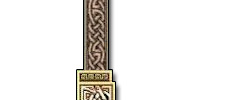Breed Standards
EJRTCA Conformation Standards
Attribute Criteria
Height
The height of the terrier shall be between 8 and 12 inches as measured at the withers with the dog standing fully erect, with 10 to 12 being ideal.
Body
Sturdy, balanced terrier. Body length slightly longer than length of leg. Length should not exceed function. Straight back with high tail set carried erect. Chest should be spanned by two hands behind the shoulder blades. The rear should be well put together with strong muscle and good an angulation. Well laid back shoulder.
Neck
Well laid into shoulder.
Head
Strong boned with powerful jaws and strong cheek muscles. Dark almond-shaped eyes, pigmented eye rims, dark black pigment on nose. Small, v-shaped ears carried close to the head. Prick, semi-prick and rose ears are acceptable but not preferred.
Teeth
The points of the upper incisors slightly overlapping the lower. May be missing up to 4 teeth.
Legs
Straight as is consistent with the short legs for which we aim.
Feet
"Hound-Like, "Fox-Like" and "Hare-Like" are all acceptable. All three are considered sound working feet for a Jack Russell.
Gait
Free, lively, fluid and well-coordinated.
Coat
Smooth, rough or broken without coat being wooly. Smooth should not be sparse. Belly and underside coated.
Color
Predominantly white with tan, black or brown markings. Ticked or mottled acceptable. Brindle not acceptable.
Faults
Nervousness, cowardice, over-aggressiveness, week bite, unsound movement, minor physical deformities.
Disqualifications
Extreme viciousness, shyness or major physical deformities (these are considered such serious traits that dogs having them are not to be used for breeding.) Undershot or overshot bites, rye mouth.
JRTCA Breed Standard
Characteristics
The terrier must present a lively, active and alert appearance. It should impress with its fearless and happy disposition. It should be remembered that the Jack Russell is a working terrier and should retain these instincts. Nervousness, cowardice or over-aggressiveness should be discouraged and it should always appear confident.
General Appearance
A sturdy, tough terrier, very much on its toes all the time, measuring between 10" and 15" at the withers. The body length must be in proportion to the height, and it should present a compact, balanced image, always being in solid, hard condition.
Head
Should be well balanced and in proportion to the body. The skull should be flat, of moderate width at the ears, narrowing to the eyes. There should be a defined stop but not over-pronounced. The length of the muzzle from the nose to the stop should be slightly shorter than the distance from the stop to the occiput. The nose should be black. The jaw should be powerful and well boned with strongly muscled cheeks.
Eyes
Should be almond shaped, dark in color and full of life and intelligence.
Ears
Small "V" shaped drop ears carried forward close to the head and of moderate thickness.
Mouth
Strong teeth with the top slightly overlapping the lower.
Neck
Clean and muscular, of good length, gradually widening at the shoulders.
Forequarters
The shoulders should be sloping and well laid back, fine at points and clearly cut at the withers. Forelegs should be strong and straight boned with joints in correct alignment. Elbows hanging perpendicular to the body and working free of the sides.
Body
The chest should be shallow, narrow and the front legs not too widely apart, giving an athletic, rather than heavily chested appearance. As a guide only, the chest should be small enough to be easily spanned behind the shoulders, by average sized hands, when the terrier is in a fit, working condition. The back should be strong, straight and, in comparison to the height of the terrier, give a balanced image. The loin should be slightly arched.
Hindquarters
Should be strong and muscular, well put together with good angulation and bend of stifle, giving plenty of drive and propulsion. Looking from behind, the hocks must be straight.
Feet
Round, hard padded, wide, of cat-like appearance, neither turning in nor out.
Tail
Should be set rather high, carried gaily and in proportion to body length, usually about four inches long, providing a good hand-hold.
Coat
Smooth, without being so sparse as not to provide a certain amount of protection from the elements and undergrowth. Rough or broken coated, without being woolly.
Color
White should predominate (i.e., must be more than 51% white) with tan, black, or brown markings. Brindle markings are unacceptable.
Gait
Movement should be free, lively, well coordinated with straight action in front and behind.
Special Notes
Old scars or injuries, the result of work or accident, should not be allowed to prejudice a terrier's chance in the show ring unless they interfere with its movement or with its utility for work or stud. A Jack Russell Terrier should not show any strong characteristics of another breed.
Faults
Shyness, Disinterest, Overly aggressive, Defects in bite, Weak jaws, Fleshy ears, Down at the shoulder, Barrel ribs, Out at elbow, Narrow hips, Straight stifles, Weak feet, Sluggish or unsound movement, Dishing, Plaiting, Toeing, Silky or woolly coats, Too much color (less than 51% white), Shrill or weak voice, Lack of muscle or skin tone, Lack of stamina or lung reserve, Evidence of foreign blood.






